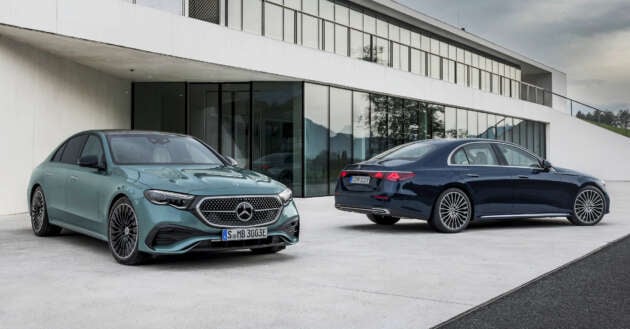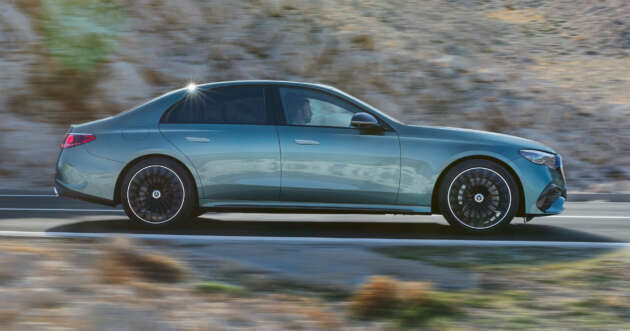The latest generation of the Mercedes-Benz E-Class has made its debut, bringing the Stuttgart marque’s mid-sized sedan entry into its 10th generation and thus sustaining one of its most traditional models in light of proliferating SUVs and dedicated electric vehicle model ranges.
Codenamed W214, this succeeds the W213 that made its debut in 2016 and the new car now measures 4,949 mm long, 1,880 mm wide and 1,468 mm tall with a wheelbase of 2,961 mm, this figure having grown 20 mm over that of its W213-generation predecessor. This benefits passenger space, as well as luggage capacity which has grown to 540 litres.
While the W214 E-Class continues to wear a very much recognisable three-box sedan shape, its front fascia features a black high-gloss insert between the grille and the headlamps, which offers tip of the hat to the styling of the brand’s EQ range of fully electric models.
Its headlamps feature LED DRLs which have been designed to mimic the shape of eyebrows, according to Mercedes-Benz, and the bonnet wears the ‘power dome’ surface shaping. Flush-fitting down handles – as seen on other models such as the EQE – can be optioned, while the tail lamps feature the three-pointed star motif in each of the two-unit assemblies.
The range of powertrains for the W214 E-Class consists of three mild-hybrid engines (one petrol and two diesels), along with three petrol-electric hybrids; all are of the inline four-cylinder configuration.
The petrol-electric PHEV range is comprised of the E 300 e, the E 300 e 4Matic and the E 400 e 4Matic. The E 300 e, along with the 4Matic (AWD) derivative packs a 1,999 cc petrol unit that outputs 204 hp and 320 Nm of torque on its own, and is paired with an electric motor that produces 129 hp and 440 Nm of torque to yield combined outputs of 308 hp and 550 Nm of torque.
The higher-rated E 400 e 4Matic produces 252 hp and 400 Nm of torque from its petrol engine, which is paired with identical outputs from the electric motor as with the E 300 duo, yielding higher combined outputs of 375 hp and 650 Nm.
Among the mild-hybrids are two diesels and one petrol, the former being the E 220 d and its 4Matic AWD sibling that packs a 1,993 cc turbodiesel making 197 hp at 3,600 rpm and 440 Nm from 1,800 rpm to 2,800 rpm. The petrol variant for Europe is the E 200, packing a 1,999 cc turbo petrol that makes 204 hp at 5,800 rpm and 320 Nm from 1,800 rpm to 4,000 rpm.
The North American market instead receives the E 350 4Matic, also packing a 2.0 litre turbo petrol albeit producing 255 hp at 5,800 rpm and 400 Nm from 2,000 – 3,000 rpm, along with a six-cylinder petrol E 450 4Matic that outputs 375 hp from 5,800 – 6,100 rpm and 500 Nm from 1,800 – 5,000 rpm.
The E 220 d does 0-100 km/h in 7.6 seconds and a top speed of 238 km/h (7.8 seconds and 234 km/h for the 4Matic), while the E 200 petrol does 0-100 km/h in 7.5 seconds and a top speed of 240 km/h.
Thus equipped, the E 300 e does 0-100 km/h in 6.4 seconds and a top speed of 236 km/h, while its 4Matic all-wheel-drive equivalent is marginally slower at 6.5 seconds to 100 km/h and a 234 km/h top end. Meanwhile, the E 400 e 4Matic does 0-100 km/h in 5.3 seconds, and a top speed of 250 km/h.
All three petrol-electric PHEV variants pack a 25.4 kWh drive battery, and all yield a three-figure electric-only range; both 4Matic variants can reach up to 109 km on battery power alone, while the E 300 e does up to 115 km; all figures are based on the EAER WLTP protocol.
For chassis, the W214 E-Class employs a four-arm configuration for the front suspension, while the rear wheels are on a five-link rear suspension layout. Standard equipment for mild-hybrid powertrain variants are fitted with the Agility Control steel-sprung suspension with adjustable damping, and rides 15 mm lower than the PHEVs in the range.
Optional air suspension kit on the W214 comes as part of the Technology pack, which brings the Airmatic setup with ADS+ continuously variable damping. Also optional is the rear-axle steering setup that offers up to 4.5 degrees of steering at the rear wheels, which reduces the turning circle by up to 90 cm, according to Mercedes-Benz.



Inside, screens take centrestage in the cabin of the W214 E-Class, where the latest iteration of the multi-screen infotainment display ensemble is called Superscreen. This setup brings the optional front passenger screen to the proceedings, and joins the main central display while the driver gets their own high-resolution display for instrumentation.
The Superscreen, when specified also brings a selfie and video camera mounted atop the dashboard, and packs an entertainment suite with a host of third-party applications. Available from launch in Europe are TikTok, the Angry Birds game, Webex, Zoom as well as the Vivaldi browser.
While the front passenger can watch dynamic content on the passenger screen, the driver will be blocked from viewing the content on the front passenger display to avoid screen-based distraction.
Accessibility for the W214 E-Class is augmented by the Digital Vehicle Key, which is available for the Apple iPhone and the Apple Watch and thus enabling the vehicle to be shared with up to 16 persons at once. The owner can assign different operating rights to different individuals, such as granting only static access to the vehicle, or also allowing it to be driven.
When on the move, passengers can use the Energizing Comfort wellness programme which aims to mitigate the symptoms of motion sickness, while the Energizing Coach programme offers individual recommendations for the wellbeing features. As part of the Thermotronic climate control option, Digital Vent Control enables the air vents to be set digitally to a particular ventilation programme, and can be done for each seat through the user profile. The air-conditioning nozzles can still be manually adjusted.
The ADAS suite in the W214 E-Class includes Active Distance Assist, Attention Assist, Active Brake Assist, Active Lane Keeping Assist, Parking Package with reverse camera and Speed Limit Assist. Attention Assist now adds a driver distraction alert, and will warn the driver acoustically and visually. If, ultimately the driver fails to respond to the alerts, the car will initiate an emergency stop via the Active Emergency Stop Assist function.
Optionally available is Driving Assistance Plus, which adds Active Steering Assist as a lane-keeping function. In the W214, when lane markings are no longer clearly visible and Active Steering Assist is no longer available, the system will alert the driver by vibrating the steering wheel.
For the European market, the W214-generation Mercedes-Benz E-Class goes on sale in the northern hemisphere summer of 2023, and the first batch of customer units are expected to arrive in showrooms in Europe in autumn.
Source: Read Full Article








